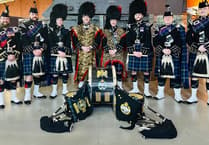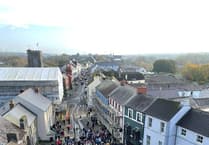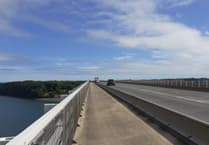Stormy weather
It's officially the wettest winter on record - something to note in the history pages! Living near the Castle Pond, however, it has been a matter of concern to see the water levels reach the heights of the past few weeks.
Water, water, everywhere -even covering the South Quay and Mill Pond Walk with the Commons awash.
The ferocious winds have made matters worse and the storm-lashed West Angle Bay and Freshwater West were featured on the News, with people unable to stand upright, while foam, snow-like, covered the road.
But the pounding of the rough seas had another effect on our coastline. On Sunday (an unusually bright, sunny day after all that wind and rain), large numbers made their way to Freshwater West, myself included, to discover that the beach had revealed some of its secrets.
The sunken forest
Made visible by the shifting sands was the sunken forest, something I had not seen before on this beach.
It excited great interest and curiosity as people poked around the tree roots and peat.
The forest reveals much about our ancient history, taking us back to a time when, long, long ago there was no beach at Freshwater, or sea for that matter. Then, Britain was not an island - land bridges connected us to the Continent.
Global warming is not new: following the end of the last great Ice Age some 10.000 years ago, continual melting of the ice sheets caused a permanent rise in sea levels.
The Irish Sea divided us from Ireland, the English Channel was flooded and cut Britain off from the rest of Europe some 6,500 years ago. This left the coastline very much as it is today.
Shipwrecks
Also attracting great interest on the beach was the remains of a ship, lying with its wooden keel turned upwards.
This is another reminder, a reminder of a treacherous coastline where many vessels perished and lives were lost.
Peter Hurlow-Jones gave me photographs of the wreck of one such ship, the Margaret Ann.
His family, John and Archibald Stephens and Son, of the East Back Engineering Works in Pembroke, were agricultural, marine and motor engineers.
They were licensed to carry out salvage work and the photographs show Peter's great uncle, Corbett Stephens, standing in front of the wreck. Peter could not tell me much about the actual ship, but, after an internet search, I found a record of the Margaret Ann. She was abandoned after striking Crow Rock on December 27, 1918, and was washed up on Freshwater West beach.
However, I do not know the name of the ship which is lying there on the sands - does anyone know?
A story of one local wreck
On the subject of wrecks, one famous, or should I say, infamous shipwreck which occurred on our treacherous coastline was that of the Loch Shiel.
David James, of the West Wales Maritime Heritage Society, relates this entertaining, local yarn in his book 'Down the Slipway'.
The full rigged ship, Loch Shiel, left Glasgow in January 1895, bound for Australia with a general cargo including a consignment of 100 per cent proof whisky, seven passengers and crew of 26.
Sailing down the Irish Sea, the weather worsened and, when off the Pembrokeshire coast it rose to a howling gale, wisely the captain decided to run for shelter into Milford Haven. With storm sails set, his ship was swept into the harbour entrance.
Unfortunately, he was unable to see the bend in the estuary that promised shelter, and in the wind-driven blinding spray and torrents of rain, he turned his ship too early. The ship ran into Thorn Island on the very corner of the estuary that he had hoped to get into, with sheltered water only a hundred yards beyond. She struck fast, the ship's company scrambled up the bowsprit to cling to the rock face. The Angle Lifeboat was launched and, in spite of the tumultuous waves and shrieking wind, all were saved. The lifeboat crew later received commendations for their bravery.
Whisky galore!
By morning, the storm had eased, the villagers went down to the beach to see the wreck and found much of her cargo, including the whisky crates, scattered along the water's edge.
News spread like wildfire and the men of the village 'liberated' all the whisky they could find for 'safe keeping'. The police and customs officers arrived and cordoned off the beach to prevent any further illicit salvage attempts. Undeterred, the wily Angle men still went to the beach and returned past the officer empty-handed.
Their findings were hidden in caches in caves and holes in the cliffs for collection later.
One enterprising man told his little daughter she was going to play a game. She was to go to the beach and collect some of Daddy's medicine from the cave, but not to let the policeman see what she had. In those days, little girls wore long bloomers that reached their ankles; she put a bottle in each leg and walked back home past the nice policeman who smiled at her. Daddy, like most of the Angle men, did little work for the next week or two, as they were all drunk - several even died of alcoholic poisoning!
Dead drunk
A week later, a case of whisky was discovered on a beach near Milford by two men. They sampled the wares and, while one fell into a drunken stupor, the other staggered home.
Two days later, the first man was found dead in a hedge, having drunk himself to death.
That same week, a father and son salvaged a keg from the wreck and tried to tow it home. The boat capsized and they drowned. The ship hung on the rocks until she gradually broke up and sank.
In the 1980s, divers exploring the wreck found yet another bottle, containing its original contents. Years after the wreck, when Angle cottages were being repaired, a bottle would be discovered reminding the local of that night."




